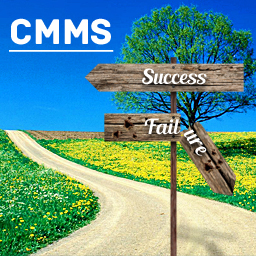Top 7 Reasons Facility Management Software Adoption Fails
 If your company is looking to purchase a new Computerized Maintenance Management System (CMMS), you probably already know the benefits of implementing a CMMS. Some of the benefits, such as increased productivity and reduced maintenance costs might be necessary for your business to succeed in today’s marketplace. While you should plan for success, part of the planning process should consider the other side of the coin; the most common reasons why facility management software fails. Up to 80% of CMMS adoptions fail due to poor implementation or lack of support. By addressing the common stumbling points early on, you and your facility department can ensure success.
If your company is looking to purchase a new Computerized Maintenance Management System (CMMS), you probably already know the benefits of implementing a CMMS. Some of the benefits, such as increased productivity and reduced maintenance costs might be necessary for your business to succeed in today’s marketplace. While you should plan for success, part of the planning process should consider the other side of the coin; the most common reasons why facility management software fails. Up to 80% of CMMS adoptions fail due to poor implementation or lack of support. By addressing the common stumbling points early on, you and your facility department can ensure success.
1. Lack of Commitment by Upper Management
Securing budget dollars to purchase a CMMS will involve getting upper management on board with the idea. Their main concerns are total cost and return on investment. When calculating total cost, consider additional and ongoing costs which include data gathering, data entry, and training. These costs will need to be included in the estimate you submit to upper management along with reasons why a CMMS is necessary. A few things to mention would be: the cost savings associated with reduced reactive maintenance and asset down-times, the need for accurate reporting and accessible work history, and reduced training time for new employees.
2. Poor or No Business Process Flow (BPF) Information
The BPF serves as a guide for management, outlining critical and time sensitive tasks for the business. Whether the maintenance system is paper based, excel based, or an existing CMMS, review of your BPF helps identify areas where efficiency improvements can save money. A key question to consider is, “what is our strategy for improvement?” The software itself is not a strategy for improvement, rather a tool to obtain it. A BPF assists in identifying those areas such as efficiency improvements and maintenance cost reductions.
3. Lack of definition and redefinition of maintenance processes
Your maintenance process should identify what you do as a department, how to report maintenance tasks, and how to measure results. Because CMMS software only manages what is defined, relying on poorly defined maintenance processes will result in poor maintenance. As a system ages, the maintenance processes will have to change. CMMS software should be flexible and simple enough to easily make process and maintenance schedule improvements.
4. Incomplete or inaccurate CMMS data
Your old system most likely contains obsolete, inaccurate, or incomplete data. Converting data in this state may do more harm than good. Decide up front the data which should be migrated. Consider including data that supports industry standardization protocols, such as recommendations from the International Organization for Standardization (ISO). Prior to data migration, review and cleanse all legacy data, formatting it specifically to your BPF. Cleansing legacy data will eliminate redundant information, improving maintenance processes and efficiency.
Further reading - CMMS Data - Obtain Accuracy By Ensuring 100% Work Order
5. Lack of vendor support
The availability of technical support is crucial in maintaining software functionality and user confidence. Ask potential suppliers these important questions up front: Who is going to be available to help me? What ongoing support is provided? Is there extra cost involved with requesting support help? You will need to look for vendors with an established history for providing excellent service and support to their customers. You might try looking at CMMS reviews online and always ask your intended supplier to provide references of current and past customers.
Try this software review site - Capterra.com
6. Employee resistance to change
People may be hesitant to change their own processes for a variety of reasons. They may think that the change is a temporary fad, or they may lack faith in their ability to learn new skills. Whatever the reason may be, it’s critical that CMMS buy-in exist across the company’s workforce. Make your new CMMS part of your employees work plan and allow employees to participate in the CMMS selection process from the very beginning.
7. Not achieving primary functionality of CMMS software
The CMMS system should provide for integrated processes giving the manager control over the maintenance of all equipment from acquisition to disposal. Incomplete and unclear maintenance processes and maintenance objectives in conjunction with poor training and customer service can inhibit achieving the primary functionality of any CMMS software.
Here are some other helpful posts:
How to Measure the Effectiveness of Your Maintenance Programs
Why Should I Choose a Web Based CMMS Application vs. On Premise?
Ryan Noble
Ryan is Q Ware's Marketing Specialist.